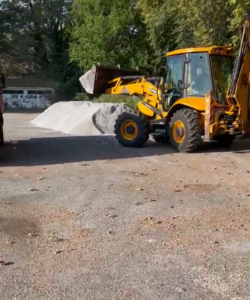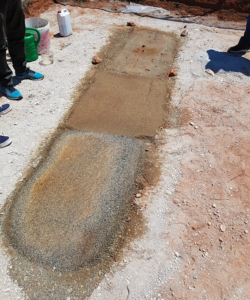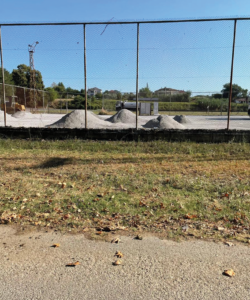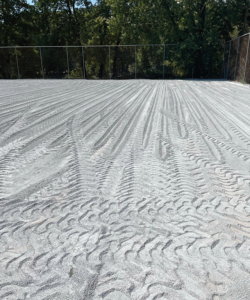
From mine haul roads, secondary roads, stockpiles and tailings to airstrips, construction sites and municipal roads, these are the applications we see most often for DUST/BLOKR®, our dust suppression solution. However, dust control is necessary in a variety of industries and settings. One such example was the Platanodasos tennis court in Katerini, Greece. Cypher Environmental distributors Vumos Oy (Finland) collaborated with Dimitris Papalampros to provide dust control for the tennis court that met the client’s needs.
This article will cover:
- Specifications and environmental considerations for dust control solution
- Selection of the ideal solution
- Application process
- Overcoming challenges
Dust Control for the Platanodasos Tennis Court
SPECIFICATIONS AND ENVIRONMENTAL CONSIDERATIONS
The Platanodasos tennis court is located in a public park in Katerini, Greece and covers a surface area of 1224 square meters. Due to the warm and arid climate, finding a sustainable surface coating that could withstand the environmental challenges proved to be a major challenge.
Conventional court coatings proved to be ineffective in this climate due to the prolonged heat, coupled with minimal rainfall. This combination of environmental factors impacted the conventional court coatings’ durability and performance. Additionally, the lack of proper angles for efficient runoff posed maintenance demands and potential risks related to rainwater drainage.
Finding a solution that could endure the climate conditions, address these challenges, and maintain sustainability and performance while meeting the municipality’s requirements became a critical objective.
SELECTING THE IDEAL PRODUCT
Cypher Environmental’s DUST/BLOKR® /SB proved to be the ideal sustainable solution for the project. Tried and tested in even the most remote and extreme climates, DUST/BLOKR®’s innovative formula offers long-lasting protection and performance, binding dust particles to maintain a clean playing surface while prioritizing environmental sustainability. With exceptional durability and the ability to withstand the warm and dry climate of Katerini, DUST/BLOKR® /SB kept the court area intact and functional.
SURFACE PREPARATION
The first task involved the removal of the old surface, including vegetation and roots, to create a clean canvas for the revitalization process. This was accomplished using a grader, which efficiently cleared the existing materials, ensuring a fresh start for the project.
Following the surface removal, the team embarked on testing and selecting the ideal materials for the top layer of the tennis court. Several options were considered, and small-scale testing was conducted to assess their compatibility and performance with Cypher’s DUST/BLOKR® /SB.
Three materials were specifically evaluated for the top layer:
- 3A natural gravel-sand mixture,
- Natural river sand,
- 0-10mm crushed rock obtained from the local quarry.
The center image in the below gallery shows the small-scale testing with the suggested materials for the top layer: 3A natural gravel-sand mixture at the edge, natural river sand in the middle and 0-10mm crushed rock from the quarry (the grey section seen in the picture). These materials were analyzed for their bonding capabilities with DUST/BLOKR® /SB and their overall suitability for the project.
- Surface prepping
- Small scale testing using the 3 suggested materials. The grey sample in the photo shows the DUST/BLOKR tested on crushed rock from the quarry
- Surface prepping
After careful evaluation, the team concluded that the crushed rock material demonstrated a significantly stronger bond with DUST/BLOKR® /SB compared to the other options. This material exhibited superior cohesion, which would enhance the long-term durability and stability of the tennis court surface. Consequently, the decision was made to proceed with the application of a 5-7 cm topical layer consisting of fine crushed rock, providing an optimal foundation for the integration of DUST/BLOKR® /SB.
APPLICATION OF SUB-LAYER
A local A3 quality fine sand-gravel mixture was evenly applied as the sub-layer material, and thorough compaction was carried out to ensure stability and durability.
APPLICATION OF FINE CRUSHED ROCK LAYER
The fine crushed rock mixed with DUST/BLOKR® /SB was spread evenly and compacted to maximize density and stability. A final layer of DUST/BLOKR® /SB was applied as a sealing barrier to enhance the longevity and strength of the surface.
OVERCOMING CHALLENGES
EXREME TEMPERATURES
To counterbalance the arid conditions and ensure proper hydration and compaction, the water quantity was adjusted to 3 liters per square meter, despite extreme temperatures reaching +36 to +40°C. Despite the challenges presented by increased water amount, the team achieved a stable and solid foundation for the tennis court.
APPLICATION OF DUST/BLOKR®-SB
For the mixed-in application, a quantity of 500ml per square meter was used to integrate the product effectively into the surface materials. An additional 200ml per square meter was applied for the topical sealing, providing an extra protective layer to bind dust particles and minimize maintenance. This careful selection and application of DUST/BLOKR® /SB were crucial in addressing the challenges of the warm and dry climate, ensuring sustainability goals were met while enhancing the playing experience.
COLLABORATION AND IMPLEMENTATION
Vumos Oy (Finland) and Mr. Dimitris Papalampros formed a strong partnership, combining their knowledge, resources, and dedication to deliver a solution for dust control for the tennis court that met the highest standards of quality, performance, and sustainability.
SUCCESSFUL COMPLETION
The Platanodasos Tennis Court project was successfully completed through careful planning, material selection, and precise application techniques. DUST/BLOKR® /SB ensured a durable, dust-free, and visually appealing surface. The sustainable solution reduced maintenance requirements and mitigated rainwater drainage risks, aligning with the municipality’s sustainability goals.
Conclusion
The Platanodasos tennis court transformation demonstrates the power of sustainable alternatives and collaboration. Cypher’s DUST/BLOKR® /SB, combined with expertise and local knowledge, resulted in a sustainable tennis court that sets an example for eco-friendly choices in sports infrastructure. This project encourages the embrace of sustainable innovation for a greener future.









